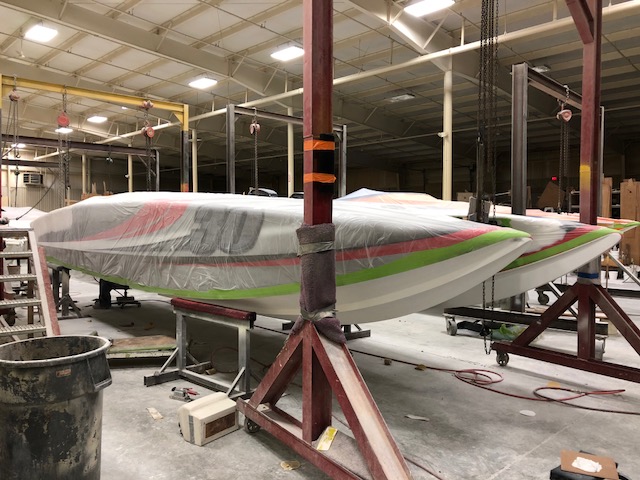It’s been over 12 years since the first 30 Skater left Douglas Marine with Sterling/Arneson power, and now it’s back at Skater to become what it was originally meant to be. Having placed his order for 30 hull #1 back in April of 2003 – before Peter Hledin even had the plug finished for the 30 mold – Dale Rayzor planned for his new rig to have outboard power. Having currently owned a 28 Skater w/ Mercury 300s at the time, Rayzor was very happy with his outboard setup, but wanted to get into something a little bigger, and with quarter canopies to get out of the wind. At the time, there was also the rumor going around the industry that Mercury would be releasing a 400hp outboard at the Miami show in Feb of 2004. This new 30 would be the perfect match for a pair of 400hp outboards, both Hledin and Rayzor figured. However, when the Miami show unveiled no new 400hp outboard, Rayzor changed his order to an inboard configured boat. There was no way Rayzor was going to build a new, bigger boat to receive the same 300hp engines as his 28. The rest was history, as the boat ended up with 800hp naturally aspirated Sterling engines and Arneson 7M drives, with a 150+ mph top speed.
Now fast forward 12 years later – Mercury Racing offers the new 400R motors, and Rayzor is tired of the maintenance and failures that come along with every 150+ mph rig. After one phone call to Hledin at the end of the 2016 boating season, Rayzor and his friend Phil Scherzer completely derigged the boat, and it was shipped back to the Skater factory for a complete makeover and conversion to outboard power. This was right around the same time that Garth Tagge and Jim Melly had their tragic accident, with whom Rayzor was friends with Melly. Having seen so many fellow performance boaters – and now a personal friend – lose their lives in 150+ mph rigs, Rayzor knew he made the right decision to tame his 30 down with outboard power.
Once the boat was back at the factory, Hledin told Rayzor that he might as well convert the boat to a new Lee Aerospace wrap windshield while it’s back there. From there, the project grew to where the entire deck was cut off from in front of the quarter canopies to the transom, as well as most of the 33” bussel. Not only would the deck receive a new full-wrap windshield receiver, but also a single rear hatch to replace the twin hatches for the inboards. Hledin also dropped the rear deckline 3”, as the rear of the boat did not need clearance for big blocks down in the bilge now. The countless hours put in on this project were mainly performed by Hledin’s lead fiberglass employee, Paulo Pena. Pena’s creativity and craftsmanship can be found in many unique features of Rayzor’s rig.
Being known throughout the industry as the “Skater Prototype”, Rayzor wanted to keep his 30 a one-off, in a market quickly being dominated by production outboard boats. Since his 30 already had a 28” tunnel extension, Rayzor decided to keep it, as well as part of the deck and hullside extensions (bussel). Pena and Rayzor spent many hours going over how Rayzor wanted the transom extension, and the results are very unique to this outboard boat. Using the tunnel extension for stairs down to the water, like the majority of the inboard Skaters now have, the boat is the first outboard Skater to have this. The deck and hullside extensions add almost a foot of length to the deck and sides of the boat, also a first for an outboard Skater.
Moving forward from the transom, and up onto the deck is another unique body feature that Pena created at the request of Rayzor. Instead of the windshield glass just ending behind the cockpit, Rayzor wanted the windshield receiver to continue back behind the glass, and taper down to the deck. This took Pena countless hours, as he had to build them from scratch – there were no molds laying around the shop that he could build them from. The finished product is somewhat of a new look for a Skater – one that Hledin said he really liked, and had been trying to get various customers to do before. Lastly, Rayzor had the deck hatch removed, as there was no need for storage under the deck with so much room in the bilge now.
In the cockpit, Rayzor chose to not use the molded dash that has pre-finished openings for round gauges, since the new dash layout will only use flat-panel Simrad displays. Pena designed the subtle curves at the bottom of the dash and the side combing of the cockpit – that will stay visible when completed, as the cockpit will not get upholstered side panels in order to save weight. The center of the dash comes down to the floor, just as the old dash did. Since Rayzor does not run a center console in his boats, this feature gives the dash/cockpit a more finished look. And if the cockpit looks smaller than all of the other outboard Skaters, it’s because it is. The rear bulkhead is 9” further forward than other outboard 30s, and the width of the cockpit is 20” narrower than the typical 318 cockpit. This is how Rayzor wanted it, to remain a 5 seat cockpit as it was before, and keep the windshield as narrow as possible for less wind resistance.
Once Skater is finished with all of the bodywork, the boat is headed to Chris Mill’s Boat Customs for a new paint job designed by Thomas Kulesia at No Coast Design. After seeing the blue/white 40SS that Kulesia designed for Ron Szolack a few years ago, Rayzor contacted Kulesia to work on renderings for the new paintjob the boat would receive. With the current paint job having been done by Chris Mills over ten years ago and still looking great, Rayzor wanted Boat Customs to again paint his 30. The collaboration of Skater, No Coast Design and Boat Customs will undoubtedly produce a one-of-a-kind rig the second time around for this prototype 30 – now to be powered as originally intended with a pair of Mercury Racing outboards on the transom.
Once the boat is painted, it will return to Skater for interior and rigging – part 2 of the story to come…..








